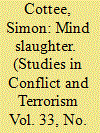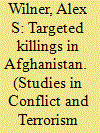| Srl | Item |
| 1 |
ID:
095228


|
|
|
|
|
| Publication |
2010.
|
| Summary/Abstract |
This article focuses on the neutralizations of the jihadi Salafi ideology. It is divided into three parts. The first describes the various rhetorical accounts that ordinary people use to neutralize conventional moral controls against inhumane conduct. The second traces how these accounts inform and drive the jihadi Salafi worldview. The third, and concluding, part of the article sketches out the policy implications of the analysis set out here, arguing that any attempt to derail the global Salafi jihad must critically undermine the core neutralizations of the jihadi Salafi ideology, since it is these which enable jihadi combatants to escape conventional moral constraints and perpetrate acts of inhumanity.
|
|
|
|
|
|
|
|
|
|
|
|
|
|
|
|
| 2 |
ID:
095232


|
|
|
|
|
| Publication |
2010.
|
| Summary/Abstract |
This report analyzes the actions taken by emergency responders in three case studies of post-9/11 terrorist attacks in Europe (Istanbul [2003], Madrid [2004] and London [2005]). It also assesses the targeting and tactical information gleaned from three European plots that either failed or were foiled by authorities. The focus of this report is on mass casualty, complex attack scenarios involving explosive or incendiary materials. Although such attacks are not limited to one particular strand of terrorism, the case studies assessed in this report are linked to or inspired by the global jihadist movement spearheaded by the al Qaeda network, since this currently constitutes the most significant threat of mass casualty bombings to the United States.
|
|
|
|
|
|
|
|
|
|
|
|
|
|
|
|
| 3 |
ID:
095227


|
|
|
|
|
| Publication |
2010.
|
| Summary/Abstract |
This article examines the coercive and deterrent utility of targeting the leaders of violent, non-state organizations with precision force. Building on the literatures on targeted killings and deterrence theory, this article provides a case study analysis of targeted killings in Afghanistan. Relying on publicly available and semi-private sources, the article presents a comparative analysis of four targeted killings conducted against Taliban leaders. Findings suggest that the eliminations degraded Taliban professionalism, diminished the group's success rates, influenced their selection of targets, and weakened morale. These findings speak to the efficacy of targeted killings in counterterrorism and counterinsurgency and to their value as both counter-capability and counter-motivation operations.
|
|
|
|
|
|
|
|
|
|
|
|
|
|
|
|
| 4 |
ID:
095230


|
|
|
|
|
| Publication |
2010.
|
| Summary/Abstract |
While al Qaeda has used the Internet primarily to spread its propaganda and to rally new recruits, the terrorist group has also relied on the Internet for financing-related purposes. Other Islamist terrorist groups, including Hamas, Lashkar e-Taiba, and Hizballah have also made extensive use of the Internet to raise and transfer needed funds to support their activities. The Internet's appeal in this regard for terrorist groups is readily apparent-offering a broad reach, timely efficiency, as well as a certain degree of anonymity and security for both donors and recipients. Unfortunately, while many governments now recognize that the Internet is an increasingly valuable tool for terrorist organizations, the response to this point has been inconsistent. For the U.S. and its allies to effectively counter this dangerous trend, they will have to prioritize their efforts in this area in the years to come.
|
|
|
|
|
|
|
|
|
|
|
|
|
|
|
|
| 5 |
ID:
095226


|
|
|
|
|
| Publication |
2010.
|
| Summary/Abstract |
This article argues that an internal armed conflict exists in Pakistan and the law of armed conflict together with human rights law applies to it. It is further argued that both the security forces of Pakistan and the Pakistani Taliban have and will continue to violate these laws and to expose the Taliban's violations alone is only a half-truth. To conclude, the reasonable prospects, or lack thereof, of the war crimes committed in this conflict to be prosecuted are discussed
|
|
|
|
|
|
|
|
|
|
|
|
|
|
|
|